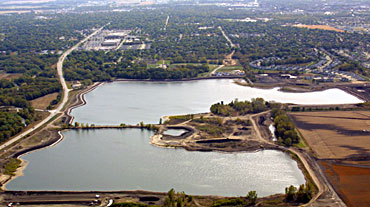Groundwater flows in and out of Ames' Ada Hayden lake
01-02-07

William Simpkins, an Iowa State professor of geological and atmospheric sciences, and Evan Christianson, a graduate student in geology and environmental science, have determined that the man-made lake at Ames' Ada Hayden Heritage Park is a dynamic part of the Ames aquifer. City of Ames photo.
Contacts:
William Simpkins, Geological and Atmospheric Sciences, (515) 294-7814, bsimp@iastate.edu
Evan Christianson, Geological and Atmospheric Sciences, (320) 296-5033, echristi@iastate.edu
Mike Krapfl, News Service, (515) 294-4917, mkrapfl@iastate.edu
Groundwater flows in and out of Ames' Ada Hayden lake
AMES, Iowa -- The activity at Ames' Ada Hayden Heritage Park isn't limited to the trails and fishing docks. It turns out there's a lot happening underneath the 1 billion gallons of water in the park's lake.
Iowa State University researchers have determined the man-made lake on the northern edge of Ames -- the former site of Hallett's Quarry -- is a dynamic part of the Ames aquifer, the underground water system that provides Ames' water supply. William Simpkins, an Iowa State professor of geological and atmospheric sciences, and Evan Christianson, a graduate student in geology and environmental science, say groundwater flows into the lake from the north, west and southwest and also into the lake from the aquifer underneath. Water leaves the lake to the southeast and east. In the process it recharges groundwater that flows beneath and parallel to the South Skunk River.
"In terms of groundwater flow, it's a classic flow-through lake," Simpkins said.
Simpkins and Christianson are studying the potential for the Ames aquifer to continue supplying drinking water to Ames. The project includes an examination and digital compilation of previous studies of the aquifer, analysis of groundwater flow and water quality and development of 2-D and 3-D computer models of the entire aquifer. The project also includes an investigation of groundwater interactions at the Ada Hayden lake. The lake provides the city with an emergency water supply that can be pumped into the South Skunk River for stream augmentation, which also helps to replenish the aquifer in the city's downtown well field.
The City of Ames is supporting the three-year project with $125,000.
Research at the Ada Hayden lake has included geophysical surveys to determine the depth of bedrock, installation of 23 monitoring wells to depths ranging from 13 to 138 feet, monthly measurements of water levels in the wells and analysis of groundwater samples for nutrients and the stable isotopes of hydrogen and oxygen.
Geologic data show that the lake bottom (the south basin's maximum depth is 61 feet and the north basin's is 48 feet) is an extremely coarse gravel and sand containing some very big boulders that mark the trend of a bedrock valley. The water contains little dissolved oxygen, little to no nitrate and high concentrations of dissolved iron and phosphorous. Stable isotopes indicate that water in the constructed wetlands has been subjected to evaporation prior to reaching the water table.
"We have good evidence that most nitrate is removed by denitrification in groundwater before it enters the lake," Simpkins said.
Water-level and stable isotope data also indicate the groundwater flows into and out of the lake, he said.
"When the lakes were excavated as part of the gravel mining operation, the company effectively took a very big bucket and scooped some of the aquifer out," Simpkins said. "But the remaining aquifer is still there moving groundwater into the South Skunk River valley."
Understanding the relationship between the lake, the South Skunk River and the Ames aquifer will be critical to maintaining the lake's volume and quality, Simpkins said. And that will be critical for using the lake as an emergency water supply.
Simpkins is completing a 2-D model and is building a 3-D computer model of the entire Ames aquifer, which covers much of Story County. Simpkins said the models will help Ames officials understand how the city's water supply could be affected by additional city wells fields, drought conditions or demands from irrigation and industrial use. The models will have the ability to simulate what happens when water is pumped from the lake into the South Skunk River -- something that happened in 1977, 1981 and 1988.
Because alluvial aquifers such as the Ames aquifer are supplying groundwater for increasing industrial, municipal, and recreational uses throughout the state -- including the state's growing ethanol industry -- Simpkins said his study could offer insights well beyond Story County.
"The various techniques that we are using in this investigation can serve as a model for other cities to use for water resource management," Simpkins said, "particularly in a time of increasing groundwater use in the state."
-30-